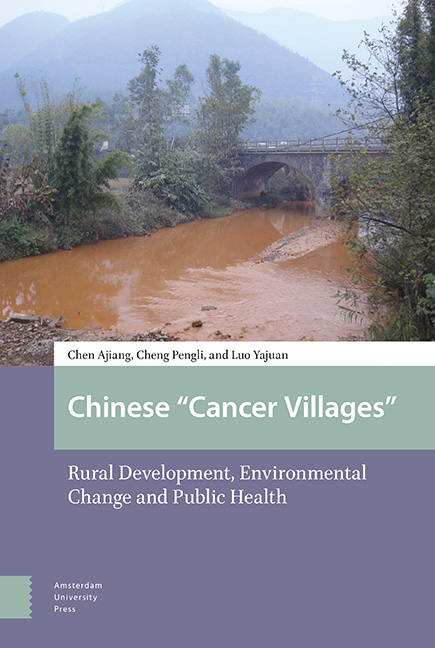Book contents
- Frontmatter
- Contents
- List of Figures, Graphs and Tables
- Acknowledgements
- Preface to the English Language Edition
- 1 Retrospective Thoughts on the ‘Cancer Village’ Phenomenon
- 2 The Ins and Outs of a ‘Cancer Village’
- 3 A Subei ‘Cancer Village’
- 4 Environmental Change and Health Risks
- 5 A Prosperous ‘Cancer Village’
- 6 Coexistence of Poverty and Cancer
- 7 Problematization and De-stigmatization
- 8 Behind the ‘High Incidence of Lung Cancer’
- 9 Villagers’ Perceptions of and Responses to the Relationship between Cancer and Pollution
- 10 Villagers Strategies for Mitigating Environmental Health Risks
- Index
- Index (Chinese) 中文索引
10 - Villagers Strategies for Mitigating Environmental Health Risks
Published online by Cambridge University Press: 20 November 2020
- Frontmatter
- Contents
- List of Figures, Graphs and Tables
- Acknowledgements
- Preface to the English Language Edition
- 1 Retrospective Thoughts on the ‘Cancer Village’ Phenomenon
- 2 The Ins and Outs of a ‘Cancer Village’
- 3 A Subei ‘Cancer Village’
- 4 Environmental Change and Health Risks
- 5 A Prosperous ‘Cancer Village’
- 6 Coexistence of Poverty and Cancer
- 7 Problematization and De-stigmatization
- 8 Behind the ‘High Incidence of Lung Cancer’
- 9 Villagers’ Perceptions of and Responses to the Relationship between Cancer and Pollution
- 10 Villagers Strategies for Mitigating Environmental Health Risks
- Index
- Index (Chinese) 中文索引
Summary
Abstract
The unclear scientific relationship between pollution and cancer, combined with weak governance systems, means that villagers have only incomplete information about pollution and disease. Their own lack of scientific knowledge is a further obstacle to their accurate perception of health risks. But villagers do not just resign themselves to their fate. They use the social structure and cultural mechanisms of the ‘familiar society’, to maximize their use of available information, and they rely on their life experience and common-sense strategies to mitigate the impact of pollution. Village social structure also affects the actions villagers take to avoid pollution. Thus, although they lack scientific guidance in mitigating health risks from pollution, their actions are informed by their own unique empirical logic.
Keywords: information circulation, local knowledge, social structure, Tai Chi, subjective agency
Over the last 30 years, rapid economic development and industrialization have caused environmental pollution and ecological degradation in China, with many negative consequences for public health. The frequent appearance of media reports about ‘cancer villages’, and ‘villages with strange illnesses’ indicates the severity of environmental health risks and reveals the high degree of public concern about them. This has become a pressing social problem.
Environmental pollution not only has big health effects, but also heavy social and economic impacts. The classic case is that of Minamata disease in Japan, which affected a total of 37,360 people, of whom more than 1,000 died. By May 1997, the issue of compensation for Minamata disease victims had basically been resolved, but the social problems it caused had not. In China, there have been numerous instances of environmentally-related disease, including the widely reported appearance of multiple ‘cancer villages’ along the Shaying River, the largest tributary of the Huai, and high rates of cancer in a village within the jurisdiction of Yancheng City, Jiangsu that suffered severe air and water pollution. High levels of lead in the blood of residents of Fengxiang in Shanxi, and the arsenic contamination incident in Yangzong Lake in Yunnan are other examples. These incidents are sufficient evidence of the severity of environmental health risks in China.
- Type
- Chapter
- Information
- 'Chinese Cancer Villages'Rural Development, Environmental Change and Public Health, pp. 283 - 296Publisher: Amsterdam University PressPrint publication year: 2020



